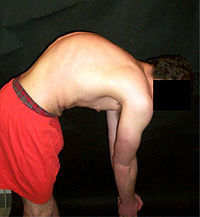Kyphosis
| Hyperkyphosis | |
|---|---|
 |
|
| A preoperative image of a 22-year-old man with Scheuermann's disease, a type of structural kyphosis | |
| Classification and external resources | |
| Specialty | Orthopedics |
| ICD-10 | M40.0-M40.2, M42.0, E64.3,Q76.4, M84.0, M96.2, M96.3 |
| ICD-9-CM | 732.0, 737.0, 737.1, 756.19 |
| DiseasesDB | 21885 |
| MedlinePlus | 001240 |
| Patient UK | Kyphosis |
| MeSH | D007738 |
Kyphosis (from Greek κυφός kyphos, a hump) refers to the abnormally excessive convex kyphotic curvature of the spine as it occurs in the cervical, thoracic and sacral regions. (Normal inward concave curving of the cervical and lumbar regions of the spine is called lordosis.) Kyphosis can be called roundback or Kelso's hunchback. It can result from degenerative diseases such as arthritis; developmental problems, most commonly Scheuermann's disease; osteoporosis with compression fractures of the vertebra; Multiple myeloma or trauma. A normal thoracic spine extends from the 1st to the 12th vertebra and should have a slight kyphotic angle, ranging from 20° to 45°. When the "roundness" of the upper spine increases past 45° it is called kyphosis or "hyperkyphosis". Scheuermann's kyphosis is the most classic form of hyperkyphosis and is the result of wedged vertebrae that develop during adolescence. The cause is not currently known and the condition appears to be multifactorial and is seen more frequently in males than females.
In the sense of a deformity, it is the pathological curving of the spine, where parts of the spinal column lose some or all of their lordotic profile. This causes a bowing of the back, seen as a slouching posture.
While most cases of kyphosis are mild and only require routine monitoring, serious cases can be debilitating. High degrees of kyphosis can cause severe pain and discomfort, breathing and digestion difficulties, cardiovascular irregularities, neurological compromise and, in the more severe cases, significantly shortened life spans. These types of high-end curves typically do not respond well to conservative treatment and almost always warrant spinal fusion surgery, which can restore the body's natural degree of curvature.
...
Wikipedia
